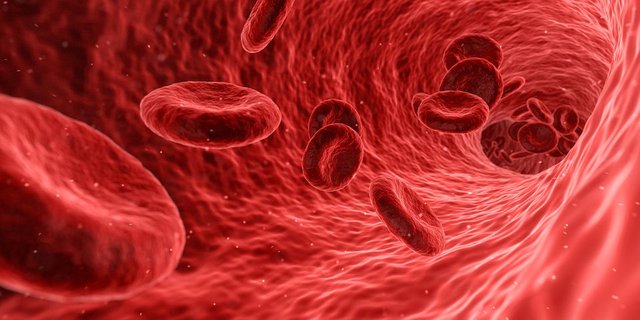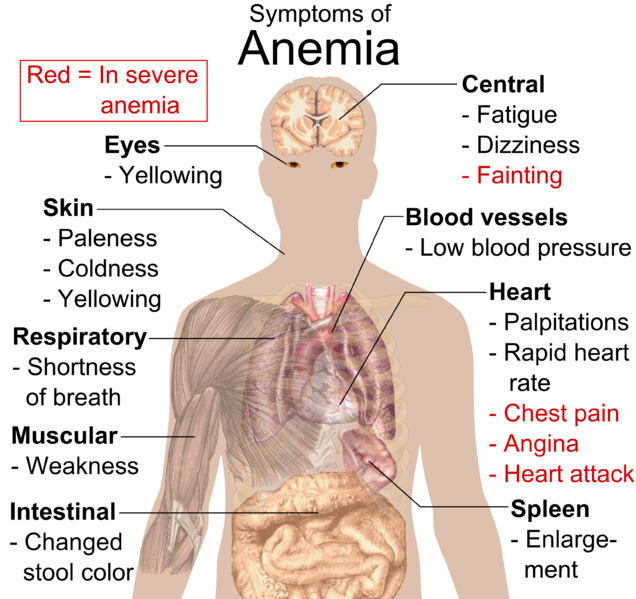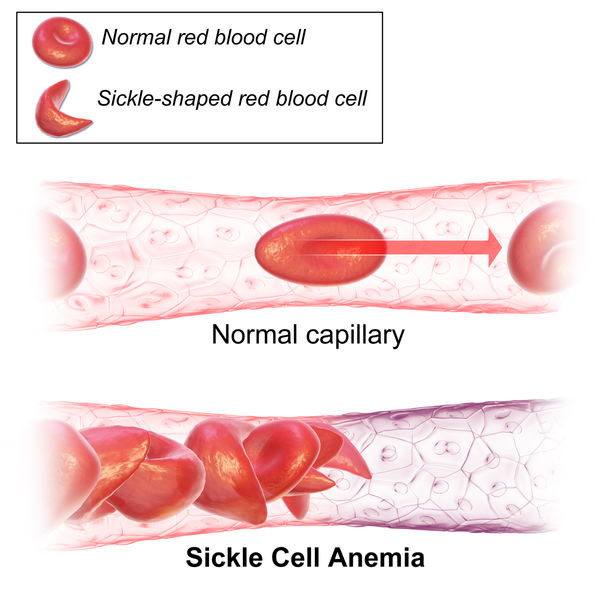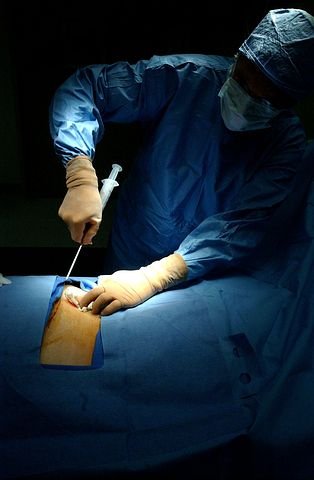Diseases of the blood #2 — Anaemia
About five and a half quarts of blood circulate through the veins, arteries, and organs of your body. This rich red stream is kept in constant circulation by your heart. When things are going well, you hardly think about this. But there are times when the blood volume may be so altered that the number of red cells in your circulation drops down a long way below the normal 5,000,000 per cubic millimeter of blood. This is the serious condition known as anaemia.

Pixabay CC0
There are several ways in which this may happen. For instance, a hemorrhage. A person whose blood level has been normal may suddenly lose a lot of blood because of a serious accident or illness. The body seeks to replace this sudden loss by pouring in more fluid or plasma. But the red cells are not easily replaced. The victim may have enough fluid in circulation, but the red cell count may be so low that he feels weak and worn-out on the slightest effort. This is the typical picture of anaemia following a rapid loss of blood.
However, slow bleeding from an ulcer in the stomach or intestine may also produce varying degrees of anaemia. If the red blood cells are lost more rapidly than the body can replace them, the patient will naturally begin to feel the effects of anaemia. A slow, steady loss of RBCs through the urinary tract will do the same thing. Anaemia also occurs from heavy menstrual bleeding. And the woman will feel tired and weak from lack of blood.
In some cases, such as in haemolytic anaemia, the blood cells are too fragile. They seem to be sensitized in some way, so that large numbers of them are destroyed in the spleen. In malaria parasites attack the RBCs, feed on the substance of the cell, and later divide into eight or sixteen new organisms that in turn invade other red cells. Certain metals, such as lead, arsenic, silver, may also destroy red cells. For some patients, the same is true of quinine and certain other drugs.
In other types of anaemia, the RBCs are not properly formed. Instead of being round and flat like a plate, they may be roughly spherical or irregular. They may then cause trouble in the spleen, and ulcers may develop in the legs, along with changes in the bones. In some rare types of anaemia the haemoglobin itself is not properly formed, so it cannot carry out its normal functions. Such cases are usually very difficult to treat.

Furthermore are brief descriptions of other types of anaemia.
Sickle-cell anaemia
This is a major problem to some people of African descent. In this disease, the red cells assume the shape of a sickle and this tends to hinder their passage through the capillaries. Not only do these patients have severe anaemia, but there are times when they will also have jaundice and pain in the joints.
Treatment
Unfortunately, we still have no good home treatment for a severe case of sickle-cell anaemia. During an acute crisis, such cases are best treated in the hospital. Cortisone may help in some cases for a while, but the outlook is not good. Sickle-cell patients should not go up into high altitudes, because the lowered oxygen in the atmosphere may bring on a severe attack.

Pernicious anaemia
In this form of anaemia, the blood cells are larger than normal, but fewer in number. Instead of 5,000,000 red cells per cubic millimeter, the count may drop to 1,000,000. Trouble arises because the “intrinsic factor “ normally produced by the stomach is not present to promote the absorption of vitamin B¹² from the intestine. This disease was once very serious, but not today.
Treatment
Frequent injections of vitamin B¹² will usually restore these patients to somewhere near normal.


Häggström, Mikael (2014). "Medical gallery of Mikael Häggström 2014". WikiJournal of Medicine 1 (2). DOI:10.15347/wjm/2014.008. ISSN 2002-4436. Public Domain.

Iron-deficiency anaemia
Sometimes the level of iron in the body may be lowered, owing to chronic blood loss, or more probably to a poor diet. Iron may also be lost from the body because of chronic diarrhoea and other conditions such as sprue. Any patient with a severe hookworm infection will also have some anaemia.
Iron may not be properly absorbed because the stomach is not producing sufficient hydrochloric acid. Sometimes this occurs during pregnancy. Unfortunately, it not only affects the mother but also the baby. Severe iron-deficiancy anaemia is seen in babies who are kept on a milk diet too long. Iron is also lost through excessive menstrual bleeding. This is often the reason why some younger women are weak and tired.
The patient usually complains of weakness, easy fatigue, and irritability. Other symptoms include heartburn, flatulence, vague abdominal pains, soreness in the mouth, numbness and tingling in the extremities, and palpitation of the heart. The skin and mucous membranes are pale, the nails are often brittle, and there are fissures or sores at the corners of the mouth. In this form of anaemia the red cells are smaller than usual and often irregularly shaped.
Treatment
The treatment for this condition includes a correction of the diet by foods containing iron. The patient should also be given some simple iron preparation such as a tablet of ferrous sulphate twice daily. Bleeding ulcer should be treated or removed by surgery. Excessive loss of blood through menstruation can now be controlled by suitable medications, but these can be given only under the direction of your doctor.

Bone marrow anaemia
Many different factors may interfere with the normal production of red cells in the bone marrow. Infections, inflammatory conditions, rheumatoid arthritis, tumours of various kinds, cancer of the bones, and certain toxic substances — all of these may contribute to bone marrow failure. X-rays, atomic explosions, and radio-active substances may also be added to the list.
In bone marrow anaemia, the patient feels tired, his skin is pale and waxy in appearance. He may have haemorrages under the mucous membranes around the eyes. His blood count may drop below 2,000,000, and his white blood count may also drop from a normal of 7,000 per cubic millimeter to less than 1,000.
Treatment
In treating such a condition, the cause must always be determined. The patient should avoid any medication to which he is allergic. Blood transfusions are often needed in these cases. Vitamin B¹² injections may help to restore the normal activity of the bone marrow, provided it has not been damaged beyond repair by radioactive substances, such as from an atomic bomb. Doctors now attempt to transfer bone marrow from one person to another in the hope of solving this serious condition.

Polycythaemia
True, polycythaemia is a slowly progressive disease in which there are too many red cells, so that the blood becomes dark and rather thick. The red blood count often rises from the normal 5,000,000 to over 10,000,000 per cubic millimeter. The true cause is unknown. Usually the patient complains of headache, weakness, dizziness, abdominal pains, and other distressing symptoms. Strokes are fairly common, and massive bleeding in the stomach may occur. The skin appears dusky and blue (cyanotic), particular in cold weather. Some patients with polycythaemia also suffer from gout. Polycythaemia sometimes occurs in congenital heart diseases of the lungs.
Treatment
The best treatment is phlebotomy in which some of the blood is drawn off at fairly frequent intervals. The patient must also be carefully watched for serious complications. A newer method is radioactive phosphorus (P³²), available only at larger medical centers. Though there is still no cure for true polycythaemia, most patients can live a rather normal life if the excess blood is removed frequently.

References for further read:

.gif)



Hi @scarletmedia!
Your post was upvoted by utopian.io in cooperation with steemstem - supporting knowledge, innovation and technological advancement on the Steem Blockchain.
Contribute to Open Source with utopian.io
Learn how to contribute on our website and join the new open source economy.
Want to chat? Join the Utopian Community on Discord https://discord.gg/h52nFrV